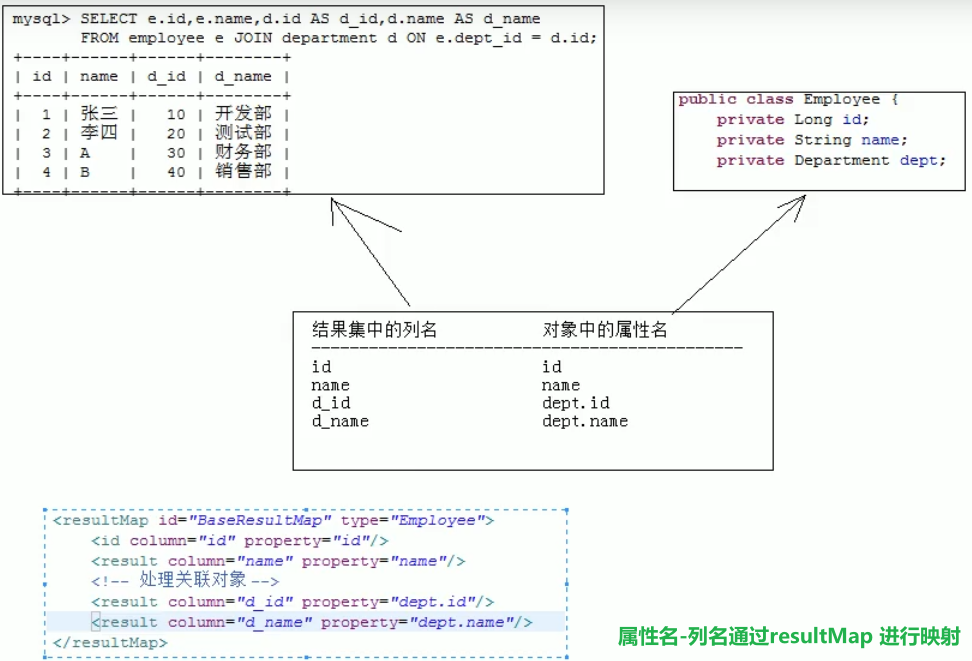学习MyBatis必知必会(8)~myBatis对象关系映射(多对一关系、一对多关系)、延迟/懒加载
一、myBatis对象关系映射(多对一关系、一对多关系)
1、多对一关系:
---例子:多个员工同属于一个部门。
(1)myBatis发送 额外SQL:
■ 案例:员工表通过 dept_id 关联 部门表,需求:查询指定员工id、name、所属的部门名称的信息。

//部门对象的接口、映射文件省略,跟员工逻辑差不多
/* 员工对象的接口 */
public interface EmployeeMapper {
Employee get(Long id);
}
<!--员工对象的映射文件-->
<!-- 解决列名和属性名不匹配问题 -->
<resultMap id="BaseResultMap" type="Employee">
<id column="id" property="id"/>
<result column="name" property="name"/>
<result column="dept_id" property="dept.id"/>
</resultMap>
<!-- 查询操作 -->
<select id="get" resultMap="BaseResultMap">
select id, name, dept_id from employee2 where id = #{id}
</select>
/* 测试:查询指定员工id、name、所属的部门名称的信息 */
@Test
public void testGet() throws Exception {
SqlSession session = MyBatisUtil.getSession();
EmployeeMapper employeeMapper = session.getMapper(EmployeeMapper.class);
Employee e = employeeMapper.get(1L);
System.out.println(e);
//需要通过查询得到的dept_id查询获取得到部门对象
/**
* 额外的查询语句,可以通过配置resultMap的association属性,让myBatis帮我们执行
*/
//手动添加额外查询语句
// Long dept_id = e.getDept().getId();
// DepartmentMapper departmentMapper = session.getMapper(DepartmentMapper.class);
// Department d = departmentMapper.get(dept_id);
// e.setDept(d);
System.out.println(e.getDept());
session.commit();
session.close();
}
-
上面是通过手动添加的额外SQL查询,通过配置resultMap的association属性,让myBatis帮我们执行如下:
<!-- 解决列名和属性名不匹配问题 -->
<resultMap id="BaseResultMap" type="Employee">
<id column="id" property="id"/>
<result column="name" property="name"/>
<!--<result column="dept_id" property="dept.id"/> -->
<!-- 额外的SQL配置方式
association元素:配置单一元素的关联关系
property 属性:对象的属性
select 属性:发送额外的sql
column 属性: 将指定的列的值传递给额外sql
-->
<association property="dept"
select="com.shan.hello.mappe r.DepartmentMapper.get"
column="dept_id"
/>
</resultMap>
(2)使用额外的 SQL 做映射配置会导致的问题:N+1问题
例如:每个员工的部门编号dept_id 是不同的,当查询所有员工的id、name、所属的部门名称的信息时就会发送额外N条SQL语句。
-
N:发送额外N条SQL语句去查询员工所属的部门名称: select name from department where id = dept_id;
-
1:查询所有员工的id、name、所属的部门的编号dept_id:select * from employee;
----解决:使用内联映射(多表查询),此时一条 SQL 语句搞定。
----处理多表查询的结果集的方法:内联映射。
(3)对象关联的查询:
方式一:额外的SQL
方式二:内联映射
(4)处理多表查询的结果集的方法【内联映射】:
-
方式一:属性名-列名 通过resultMap的
子元素result进行映射配置[内联映射-使用result]:

-
方式二:属性名-列名 通过resultMap的
子元素association进行映射配置[内联映射-使用association]

(5)多对一关系配置总结:
★使用association元素,配置单一对象属性。
- 方式一:额外的SQL[分步查询],一般需要进入另外一个页面展示更加详细的信息。
- 方式二:内联映射[多表查询],常用。需要在列表中显示关联对象的数据,使用内联映射,否则会出现N+1问题。
2、一对多关系配置:
---例子:一个部门有多个员工。
(1)一对多关系-额外的SQL:
<!-- 针对单一对象的属性,使用association元素 -->
<!-- 针对集合类型的属性,使用collection元素 -->
<!-- 额外的SQL配置方式
collection元素:配置集合类型元素的关联关系
property 属性:对象的属性
select 属性:发送额外的sql
column 属性: 将指定的列的值传递给额外sql
-->
<resultMap id="BaseResultMap" type="Department">
<id column="id" property="id"/>
<result column="name" property="name"/>
<!--<result column="" property="emps"/> -->
<collection property="emps"
select="com.shan.hello.mapper.EmployeeMapper.get"
column="id" >
</collection>
</resultMap>
<select id="get" resultMap="BaseResultMap">
select id, name from department where id = #{id}
</select>
(2)一对多关系-内联查询:
<!-- 针对单一对象的属性,使用association元素 -->
<!-- 针对集合类型的属性,使用collection元素 -->
<resultMap id="BaseResultMap" type="Department">
<id column="id" property="id"/>
<result column="name" property="name"/>
<!--<result column="" property="emps"/> -->
<!--
内联查询:ofType是集合中泛型的类型
-->
<collection property="emps" ofType="Employee">
<result column="e_id" property="id"/>
<result column="e_name" property="name"/>
<result column="e_dept_id" property="deptId"/>
</collection>
</resultMap>
<select id="get" resultMap="BaseResultMap">
<!-- select id, name from department where id = #{id} -->
select d.id, d.name, e.id e_id, e.name e_name, e.dept_id e_dept_id from department d
join employee2 e on d.id = e.dept_id where d.id = #{id}
</select>
二、设置延迟/懒加载
<!-- 全局配置文件 -->
<settings>
<!-- 懒加载/延迟加载,开启延迟加载功能 -->
<setting name="lazyLoadingEnabled" value="true"/>
<!-- 设置不要积极地去查询关联对象 -->
<setting name="aggressiveLazyLoading" value="false"/>
<!-- 延迟加载的触发方法 -->
<setting name="lazyLoadTriggerMethods" value="close"/>
</settings>
- 动态代理-增强功能--延迟加载
总结:多对一、一对多关系的单属性对象/集合属性对象,使用association或collection元素?使用额外SQL或内联查询?
-
针对【单属性对象】:使用
assoication元素,通常需要使用多表查询操作,即内联查询 -
针对【集合属性对象】:使用
collection元素,通常还要使用延迟加载,即额外SQL处理
本文来自博客园,作者:一乐乐,转载请注明原文链接:https://www.cnblogs.com/shan333/p/15866677.html



【推荐】国内首个AI IDE,深度理解中文开发场景,立即下载体验Trae
【推荐】编程新体验,更懂你的AI,立即体验豆包MarsCode编程助手
【推荐】抖音旗下AI助手豆包,你的智能百科全书,全免费不限次数
【推荐】轻量又高性能的 SSH 工具 IShell:AI 加持,快人一步
· TypeScript + Deepseek 打造卜卦网站:技术与玄学的结合
· Manus的开源复刻OpenManus初探
· AI 智能体引爆开源社区「GitHub 热点速览」
· 三行代码完成国际化适配,妙~啊~
· .NET Core 中如何实现缓存的预热?